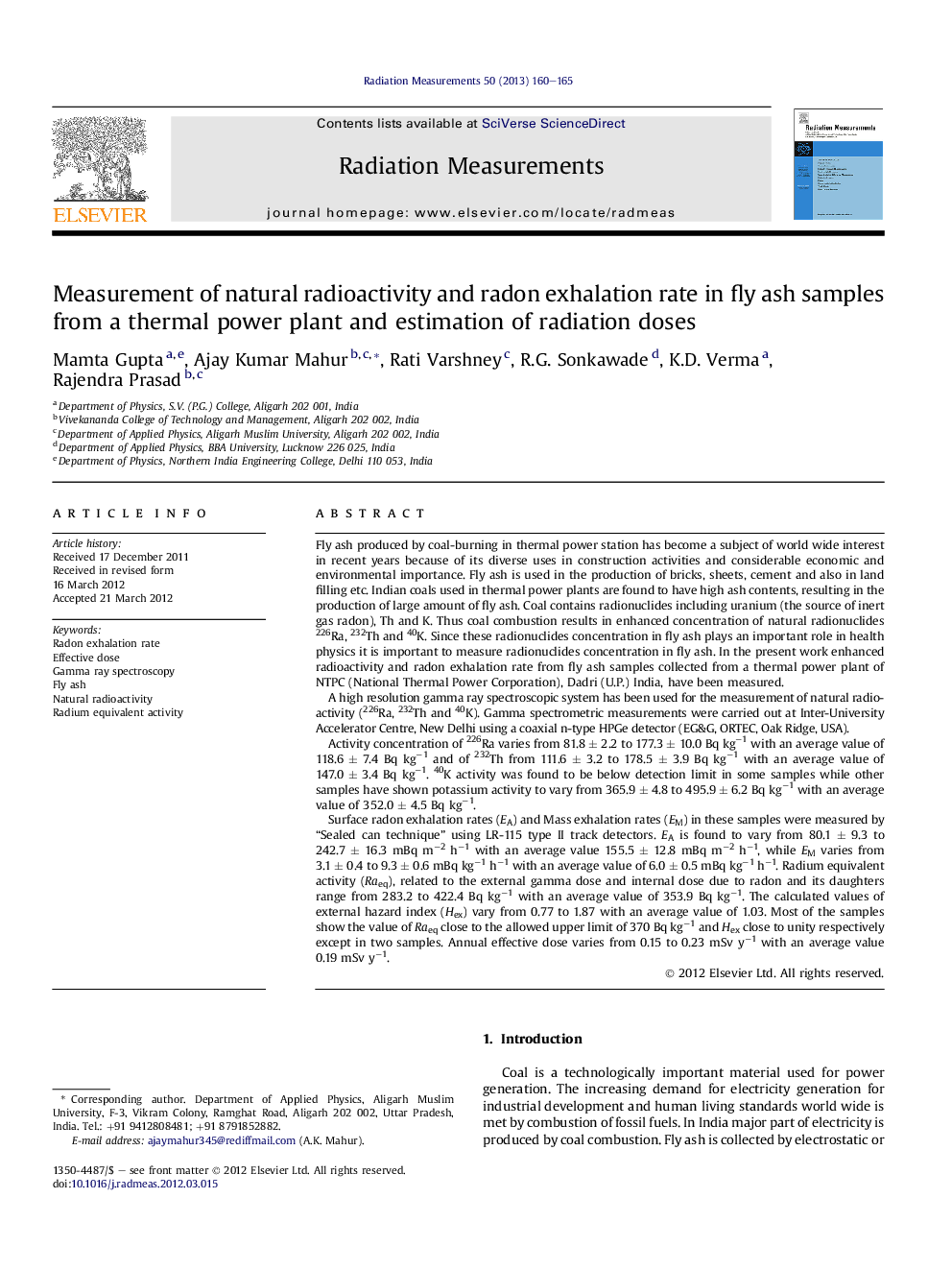| کد مقاله | کد نشریه | سال انتشار | مقاله انگلیسی | نسخه تمام متن |
|---|---|---|---|---|
| 1885074 | 1533438 | 2013 | 6 صفحه PDF | دانلود رایگان |

Fly ash produced by coal-burning in thermal power station has become a subject of world wide interest in recent years because of its diverse uses in construction activities and considerable economic and environmental importance. Fly ash is used in the production of bricks, sheets, cement and also in land filling etc. Indian coals used in thermal power plants are found to have high ash contents, resulting in the production of large amount of fly ash. Coal contains radionuclides including uranium (the source of inert gas radon), Th and K. Thus coal combustion results in enhanced concentration of natural radionuclides 226Ra, 232Th and 40K. Since these radionuclides concentration in fly ash plays an important role in health physics it is important to measure radionuclides concentration in fly ash. In the present work enhanced radioactivity and radon exhalation rate from fly ash samples collected from a thermal power plant of NTPC (National Thermal Power Corporation), Dadri (U.P.) India, have been measured.A high resolution gamma ray spectroscopic system has been used for the measurement of natural radioactivity (226Ra, 232Th and 40K). Gamma spectrometric measurements were carried out at Inter-University Accelerator Centre, New Delhi using a coaxial n-type HPGe detector (EG&G, ORTEC, Oak Ridge, USA).Activity concentration of 226Ra varies from 81.8 ± 2.2 to 177.3 ± 10.0 Bq kg−1 with an average value of 118.6 ± 7.4 Bq kg−1 and of 232Th from 111.6 ± 3.2 to 178.5 ± 3.9 Bq kg−1 with an average value of 147.0 ± 3.4 Bq kg−1. 40K activity was found to be below detection limit in some samples while other samples have shown potassium activity to vary from 365.9 ± 4.8 to 495.9 ± 6.2 Bq kg−1 with an average value of 352.0 ± 4.5 Bq kg−1.Surface radon exhalation rates (EA) and Mass exhalation rates (EM) in these samples were measured by “Sealed can technique” using LR-115 type II track detectors. EA is found to vary from 80.1 ± 9.3 to 242.7 ± 16.3 mBq m−2 h−1 with an average value 155.5 ± 12.8 mBq m−2 h−1, while EM varies from 3.1 ± 0.4 to 9.3 ± 0.6 mBq kg−1 h−1 with an average value of 6.0 ± 0.5 mBq kg−1 h−1. Radium equivalent activity (Raeq), related to the external gamma dose and internal dose due to radon and its daughters range from 283.2 to 422.4 Bq kg−1 with an average value of 353.9 Bq kg−1. The calculated values of external hazard index (Hex) vary from 0.77 to 1.87 with an average value of 1.03. Most of the samples show the value of Raeq close to the allowed upper limit of 370 Bq kg−1 and Hex close to unity respectively except in two samples. Annual effective dose varies from 0.15 to 0.23 mSv y−1 with an average value 0.19 mSv y−1.
► High resolution gamma ray spectroscopy with HPGe for 226Ra, 232Th & 40K activity concentration in fly ash.
► Lungs damage risk from radon inhalation; Radon exhalation measurements using SSNTD's.
► External hazard index, gamma absorbed dose rates & annual effective dose rates estimation.
► Values higher than from the world average.
► Positive correlation between Radium activity concentration and radon exhalation rate.
Journal: Radiation Measurements - Volume 50, March 2013, Pages 160–165